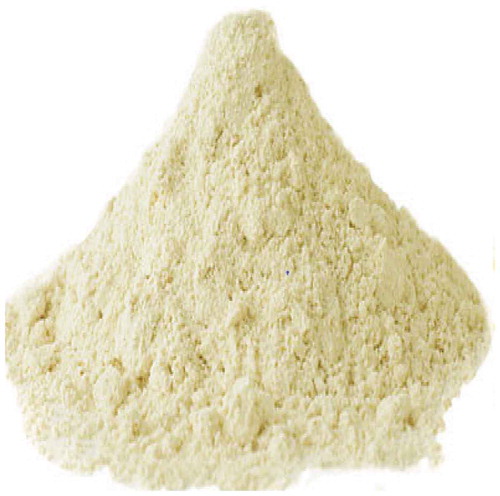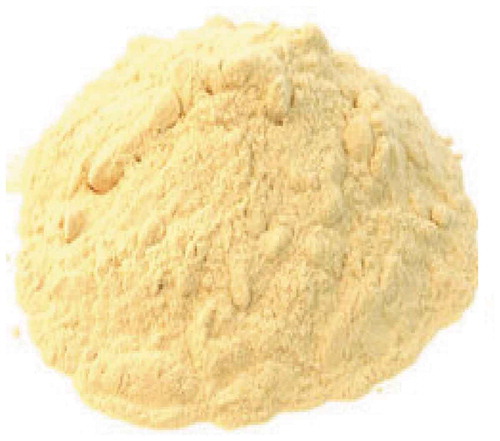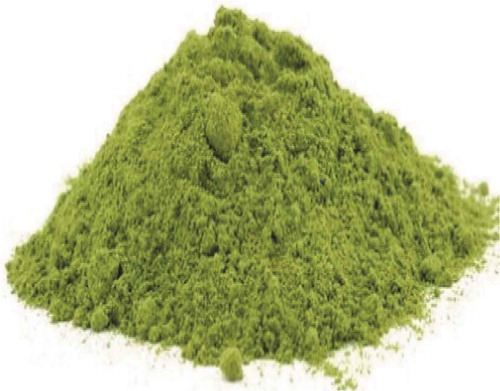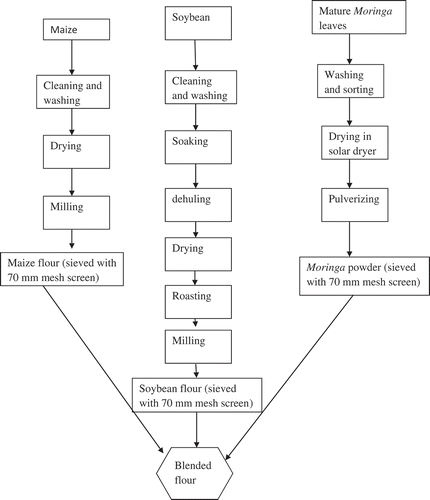Abstract
Malnutrition is a major problem in Ethiopia. In Tigray regional state of Ethiopia, under-nutrition (disorders of nutrition) is very high. This study aimed to assess ash, moisture, protein fiber and fat contents of blended flours. The raw materials were maize (Zea mays) Melkassa-6 variety, soybean (Glycine max) Wagaye variety and moringa (Moringa oleifera) leaf. The three formulated flours were (R65) 65:30:5, (R60) 60:30:10 and (R55) 55:30:15 with maize flour, soybean flour and moringa leaf powder, respectively. Each of the ingredients was mixed in predetermined portions to obtain enriched flour. Ash, moisture, protein, fat and fiber of the enriched flours were assessed and compared to control (100% maize flour). Higher amount of ash was observed in R55 (4.3%), whereas higher moisture were found in control (7.8%). Protein content increased significantly (p < 0.05) from 8.2% in control to 17.2% in R55 as the level of moringa leaf powder increased from 5% to 15%. Fat content increased significantly (p < 0.05) from 4.5% in control (maize flour) to 10.99% in R55. Lower fiber content was recorded in R65 (2.65). As moringa leaf powder increased carbohydrate content decreased significantly (p < 0.05) from 66.1% in R65 to 57.3% in R55. Higher energy was recorded in composite flour as compare to control (maize flour). The study showed that blending locally available food grains with moringa leaf powder can enhance proximate composition.
PUBLIC INTEREST STATEMENT
Malnutrition literally means mal nutrition in which mal means abnormal; therefore, malnutrition is abnormal nutrition that occurs due to either lack or excess of one or more nutrient that is needed for our body. Malnutrition in all its forms include over nutrition (overweight, obesity and resulting diet-related non-communicable diseases), under nutrition (stunting, wasting and underweight) and micronutrient deficiency (inadequate vitamins and minerals). Under nutrition mostly affects low- and middle-income countries in which around 45% deaths among children under 5 years of age are linked to this. Research exploration in complementary food processing using locally available materials might lower the death of under aged children and contribute to nutrition security.
Competing Interests
The author declares no competing interests.
1. Introduction
The period from 0 to 24 months is one of the most critical times for optimal growth and health and it is the peak age of growth faltering; however, occurrence of malnutrition in this age group is difficult to reverse to normal status, and can cause a major risk factor for childhood morbidity and mortality (Martorell, Kettel, & Schroeder, Citation1994). Inappropriate feeding and misconception can cause poor physiological and mental development, as a result of this, some beliefs indicate that feeding children food such as curd can cause cold and cough (Lodha & Bharti, Citation2013)
Complementary foods are foods that are introduced to children at six months of age in the form of liquid, semisolid and solid. Before six months breast milk contains all the nutrients that are needed for the growth of the child and nothing is given to children even water; thereafter, to meet their nutritional requirements, infants should receive nutritionally adequate and safe complementary foods, while continuing to breastfeed up to two years or beyond (WHO, Citation2019). Nutrition education has great impact to start complementary food at the age of six months (Berhanu, Abegaz, & Kinfe, Citation2015). In some parts of Ethiopia, the most liked complementary food given to children at six months old is maize, inset and very rare legumes that are nutritionally in adequate and unsafe, and around 80.4% of the complementary foods prepared for children are as normal as the food prepared for the whole family (Berhanu et al., Citation2015), such as Kitta (flat and thin bread), bread and injera fitfit (mixed injera with stirred legume powder in water).
Feeding children with complementary foods prepared from maize, soybean and moringa leaves powder increase some anthropometric measurements (weight and head circumference) and serum iron level and Hb level as compare to control diet (maize and soybean) (Nwosu, Nnam, Ibeziako, & Maduforo, Citation2014). The complementary foods prepared for infants from locally available agricultural products should meet quality of infant milk formula (Ojinnaka, Ebinyasi, Ihemeje, & Okorie, Citation2013). A study conducted at south Ethiopia showed that 75% of the surveyed mothers use maize as a main cereal for complementary food preparation (Berhanu et al., Citation2015). Due to inappropriate complementary food introduction to children, the prevalence of stunting, underweight and wasting in Tigray is 46.9%, 33% and 11.6%, respectively (Mulugeta et al., Citation2010).
According to CSA (Central Statistical Authority), Federal Democratic Republic of Ethiopia (Citation2006), teff, sorghum, maize and wheat are the main staple food grains in Ethiopia. From the total grain production, maize and soybean accounts in 2016 were 71508354.11 and 812418.33 quintals, respectively. In Tigray regional state, maize and soybean production were 1379089.52 and 94163.2 quintals, respectively (CSA, Citation2006).
Moringa oleifera leaves are very rich in some macro- and micronutrients and can be consumed fresh, cooked or dried. Dried moringa leaf powder can be stored in air-tight containers, protected from light and humidity, and kept below 24°C and can be added into any dishes (Mishra, Singh, & Singh, Citation2012). Moringa in Ethiopia is called “Shiferaw”. Moringa leaf powder is consumed as a tea in cafeteria and at home, and at southern part of Ethiopia two spoonful of moringa powder is added in to dishes every day (Alemu and Kelemu, Citation2013). Even if moringa is abundant in Tigray, its use and consumption is very low due to limited awareness.
Soybean is known for its high content of protein value above 43%, and contains some micronutrients helpful for brain development, especially for infants (Nnam, Citation2000). This study reports on proximate composition of maize-based complementary flour blended soybean flour and moringa leaf powder.
2. Materials and methods
2.1. Materials
Maize (Zea mays), Melkassa-6 variety grains, soybean (Glycine max) Wageye variety seeds and Moringa oleifera leaf were used for the study. The maize and soybean were collected from Mekelle Agricultural Research Institute and Mytsebri Agricultural Research Institute, respectively, and Moringa oleifera leaves were collected from Wukro Agricultural College, Tigray, Ethiopia.
2.2. Preparation of materials
Sample materials were cleaned manually to remove husks, damaged grains, stones, dust, light materials, glumes, stalks, undersized and immature grains, and other extraneous materials.
Cleaned and graded maize was milled with a laboratory harmer miller (Thomas Willey, model ED-5, Germany) and sieved to separate the bran from the flour with 70 mm mesh screen. The flour with moisture content of 7.8% was packed in polyethylene bags and stored at room temperature until used.
Pure soybean seeds were boiled in boiling water in a ratio of 1:3 (w/v) for 1 h. The seeds were dehulled manually and dried in sun spread for 4 days until it was hard and slightly roasted for 15 min. Roasted soybean was milled in a laboratory harmer miller (Thomas Willy, Model ED-5, Germany) to fine flour. The flour was sieved through 70 mm mesh screen and stored in polyethylene bags at room temperature with moisture content of 2.5% until used.
Fresh Moringa oleifera leaves were plucked, washed and shade-dried. The leaves were completely dried within 2 h inside solar drier. Then, it was pulverized and packed in polyethylene bag and stored at room temperature with a moisture content of 4.8% until used.
2.3. Blend formulations
This research was done based on studies done by Nwosu et al. (Citation2014) and Shiriki, Igyor, and Gernah (Citation2014). Nwosu et al. (Citation2014) prepared his experimental diet from maize flour, soybean flour and moringa leaf powder in the ratio of 60:30:10, respectively, and Shiriki et al. (Citation2014) varied the moringa level from 5% to 15% in his experimental diet prepared from wheat flour, soybean flour, peanut and moringa leaf powder. The blends (Table ) were formulated with ingredients that would provide adequate proximate composition. Three different blend formulations were prepared from maize flour, soybean flour and moringa leaf powder.
Table 1. Mixing ratio of ingredients for blended flours
2.4. Analysis of proximate chemical composition
Proximate chemical composition analysis such as moisture, crude protein, crude fat, crude fiber and ash were determined according to standard methods described by AACC (Citation2000), while carbohydrate was determined by difference as described by Ihekoronye and Ngoddy (Citation1985). Energy value was calculated using the Atwater factors of 4, 9 and 4 for protein, fat and carbohydrate, respectively (Chaney, Citation2006).
3. Experimental design
Simple mixture design was used to determine the effect of blends of maize flour, soybean flour and Moringa oleifera powder. The proportion of maize varies from 55% to 65% and moringa leaf powder from 5% to 15%, keeping soybean flour constant 30%; while 100% maize was used as a control. The ingredients were prepared in triplicate and analyzed for statistical validity.
4. Statistical analysis
Data was analyzed using Statistical Analysis Systems (SAS) package (version 9.1.3, American multinational developer of analytics software, USA). The results were reported as values of mean ± standard deviation. Data was compared on the basis of standard deviation of the mean values. One-way analysis of variance (ANOVA) was used to separate means.
5. Results
The proximate composition of the maize flour, soybean flour and moringa leaf powder are shown in Table . Moringa powder had significantly higher content of ash as compared to maize and soybean flour. Higher and lower moisture content were found in maize flour and soybean flour respectively. Protein and fiber contents were significantly higher (p < 0.05) in soybean flour and moringa powder, respectively, as compare to control (maize flour). Higher carbohydrate was observed in maize flour and lower in soybean flour. Soybean flour was found to be superior in energy.
Table 2. Proximate and energy composition of soybean flour, maize flour and Moringa olifera powder
Values are means ± standard deviations of triplicate determinations. Means with the different superscript (a, b, c) within the row are significantly different (p < 0.05).
The proximate composition of maize flour (control) and three blended flour are shown in Table . R55 had higher ash content. All the three blended flour had significantly lower moisture content as compare to maize flour (control). Maize flour (control) had significantly lower protein content as compare to all blended flours. Fat content increased significantly in the blend as compare to control, while carbohydrate content decreased significantly. Higher energy was found in R65 than the other flour samples.
Table 3. Proximate and energy composition of the control and composite flour
Values are means ± standard deviations of triplicate determinations. Means with the different superscript (a, b, c) within the row are significantly different (p < 0.05).
6. Discussion
6.1. Nutrient and energy contents of the control and composite flour
The focus of this study was to explore the use of maize flour, soybean flour and moringa leaf powder as potential food ingredients that can add value to complementary foods. Malnourished babies are at higher risk of death in infancy and are more likely to face lifelong cognitive and physical deficits and chronic health problems due to protein–energy malnutrition (PEM) (USAID/ENGINE/Save the children, Citation2012). Children under 6 years of age are vulnerable to PEM due to poor attention (Joshi, Joshi, Singh, Joshi, & Khan, Citation2011).
The moisture content of the blended flour is in the limit of FAO/WHO recommended value (<10%), which decreased significantly (p < 0.05.) from 8.7% in maize flour (control) to 5.8% in R55. Moisture has an implication in terms of the consistency/texture and microbiological quality of food (Makinde & Ladipo, Citation2012). Complementary foods should be free of microbial contamination that might prone children to diarrhea. Olaoye, Onilude, and Idowu (Citation2006) reported that lower moisture content in food have an implication to prevent from microbial contaminations. This finding agreed to the study of Nwosu et al. (Citation2014) and Abraham et al. (Citation2013) that reported decreasing moisture content as moringa leaf powder level increased in their complementary food prepared from maize flour, soybean flour and Moringa leaf powder.
There was significant (p < 0.05) increase in protein content with increasing level of Moringa leaf powder from 8.2% in maize flour (control) to 17.2% in R55. This could be due to substitution effect caused by the high protein content of Moringa leaf powder. Abraham et al. (Citation2013) reported that Moringa leaf powder have the capability to increase the protein level in bread produced from wheat flour, soybean flour and Moringa olifera leaf powder. The protein is relatively higher than what was reported by Nwosu et al. (Citation2014) in his complementary food prepared from maize flour, soybean flour and Moringa oleifera leaf powder. The protein value obtained agreed with the recommendations of FAO/WHO (16.7%).
The fat content of the blended flour is relatively higher than the maize flour (control), which fulfills the recommended dietary allowance by FAO/WHO (>6%). The codex standard recommends the fat content of cereal based processed diets not to exceed 3.3 g/kCal (Codex, Citation2006). Dietary fat provide energy, essential fatty acids, transport fat soluble vitamins (A, D, E and K) and promotes palatability of food (Makinde & Ladipo, Citation2012; Michaelsen, Citation2000). Abraham et al. (Citation2013) reported an increase fat content in his maize–soybean–moringa bread as the level of moringa leaf powder increased in the blend
Fiber content of the blended flour decreased significantly (p < 0.05) from 11.12% in maize flour (control) to 2.96% in R65. Special attention should been given to complementary foods prepared for infants since intestine of children is not mature enough to await high fiber content. Fiber may affect the efficiency of absorption of various nutrients of significance in diets with marginal nutrients content (Asma et al., Citation2006).
The blended flour showed significantly (P < 0.05) higher ash content (3.5–4.3%) compared to maize flour (control) (1.3%). Within the blended flour, there were significant differences (P < 0.05) in the ash content. The ash content is higher than 3.08% and 1.65% is reported by Nwosu et al. (Citation2014) and Abraham et al. (Citation2013), respectively.
There was significant decrease (p < 0.05) in carbohydrate content from 67% in control (maize) to 57.3% in R55. As the level of moringa leaf powder addition increased the carbohydrate content decreased. The differences observed could be due to low carbohydrate content in moringa leaf powder (46.3%) as compared to maize flour (67%) (Table ). A slight decreasing result was reported by Abraham et al. (Citation2013) in his bread made from maize flour, soybean flour and moringa leaf powder.
The energy content is relatively higher than that of recommended by WHO/FAO for infants of developing countries 200 kCal for 6–8 months of age and 300 kCal for 9–11 months of age; however, it is lower for 12–23 months of age that requires 550 kCal per day. The energy content is higher than reported by Kebebu, Whiting, Dahl, Henry, and Kebede (Citation2013).
7. Conclusion
The finding of this research showed that addition of moringa leaf powder to locally available food ingredients enhances proximate value, such as ash, protein and fat contents, which could be good remedy for protein–energy malnutrition (PEM). In Ethiopia, specifically in Tigray, PEM is public concern; therefore this study might have an implication to reduce the severity of PEM.
Additional information
Funding
Notes on contributors
Desalegn Gebrezgi
Desalegn Gebrezgi is a nutrition professional working as a researcher at Tigray Agricultural research institute in core process of Mekelle Agricultural Mechanization and Rural Energy Research Center, Agro-processing and Post-harvest Technology Department. He carried out all material collection, laboratory analysis, as well as statistical analysis of the data. He has obtained his MSc in Applied Human Nutrition and currently executing different researches in the area of food processing and nutrition at Tigray agricultural research institute, Tigray, Ethiopia.
References
- AACC. (2000). Approved methods. St. Paul, MN: American Association of Cereal Chemists. Methods 46-13.
- Abraham, I. S., Joseph, O. A., & Dick, I. G. (2013). Effect of Moringa oleifera leaf powder supplementation on some quality characteristics of wheat bread. Food and Nutrition Sciences, 4, 270–10. doi:10.4236/fns.2013.43036. Retrieved from http://www.scirp.org/journal/fns
- Alemu, D., & Kelemu, K. (2013). Commercialization of Moringa Production in Ethiopia: Establishing model value chains for Moringa in Ethiopia. Researchgate, publication: 316647971. Retrieved from https://www.researchgate.net/
- Asma, M. A., & Babiker, E. E. l., El Tinay A. H. (2006). Development of weaning food from sorghum supplemented with legumes and oil seeds. Food and Nutrition Bulletin, 27(1), 26–34.
- Berhanu, B., Abegaz, K., & Kinfe, E. (2015). Assessment of knowledge and practices on complementary food preparation and child feeding at Shebedino, Sidama Zone, Southern Ethiopia. International Journal of Food Science and Nutrition Engineering, 5(2), 82–87. doi:10.5923/j.food.20150502.02
- Chaney, S. (2006). Principles of nutrition I. Macronutrients. In T. M. Devlin (Ed.), Textbook of biochemistry, with clinical correlation (6th ed., pp. 1071–1090). NewYork, NY: John Wiley and sons.
- Codex. (2006). Codex standards for processed cereal-based foods for feeding infant and young children, CODEX STAN 047-1981, (Rev.1-2006).
- CSA (Central Statistical Authority), Federal Democratic Republic of Ethiopia. (2006). Statistical abstracts. Addis Ababa: CSA.
- Ihekoronye, I. A., & Ngoddy, P. O. (1985). Effects of dehulling on functional and sensory properties of flours from black beans. Integrated food sci- ence and technology for the tropics (pp. 125–127). London: MacMillan Publishers Ltd..
- Joshi, H. S., Joshi, M. C., Singh, A., Joshi, P., & Khan, N. I. (2011). Determinants of protein energy malnutrition (PEM) in 0-6 years children in rural community of Bareilly. Indian Journal of Preventive and Social Medicine, 42(2), 154–158.
- Kebebu, A., Whiting, S. J., Dahl, W. J., Henry, C. J. (2013). Formulation of a complementary food fortified with broad beans (vicia faba) in southern Ethiopia. African Journal of Food, Agriculture, Nutrition and Development, 13(3).
- Lodha, S., & Bharti, V. (2013). Assessment of complementary feeding practices and misconceptions regarding foods in young mothers. International Journal of Food and Nutritional Sciences, 2(3). e-ISSN 2320 –7876. Retreived from. www.ijfans.com
- Makinde, F. M., & Ladipo, A. T. (2012). Physico-chemical and microbial quality of sorghum based complementary food enriched with soybean (Glycine max) aand sesame (sesamum indicum). Journal of Food Technology, 10(2), 46–49. ISSN:1684-8462. doi:10.3923/jftech.2012.46.49
- Martorell, R., Kettel, L., & Schroeder, G. (1994). Macro level approaches to improve the availability of complementary foods. New York, NY: Food Nutrition Buliletin.
- Michaelsen, K. F. (2000). Feeding and nutrition of infants and young children: Guidelines for the WHO European region, with emphasis on the former Soviet countries (No. 87). WHO Regional Office Europe.
- Mishra, S. P., Singh, P., & Singh, S. (2012). Processing of Moringa oleifera leaves for human consumption. Bulletin of Environment, Pharmacology and Life Sciences, 2(1), 28–31. Online ISSN 2277-1808.
- Mulugeta, A., Hagos, F., Kruseman, G., Linderhof, V., Stoecker, B., Abraha, Z., … Samuel, G. G. (2010, June). Child malnutrition in Tigray, Northern Ethiopia. East African Medical Journal, 87(6), 248–254.
- Nnam, N. M. (2000). Chemical evaluation of mulitimixes formulated from some local staples for use as complementary foods in Nigeria. Plant Foods for Human Nutrition, 55, 255–263. doi:10.1023/A:1008176903750
- Nwosu, O. I. C., Nnam, N. N., Ibeziako, N., & Maduforo, A. N. (2014). Development and nutritional evaluation of infant complementary food from maize (Zea mays), soybean (Glycine max) and Moringaoleifera leaves. International Journal of Nutrition and Food Sciences, 3(4), 290–299. ISSN: 2327-2694 (Print); ISSN: 2327-2716 (Online). doi:10.11648/j.ijnfs.20140304.19
- Ojinnaka, M. C., Ebinyasi, C. S., Ihemeje, A., & Okorie, S. U. (2013). Nutritional evaluation of complementary food gruels formulated from blends of soybean flour and ginger modified cocoyam starch. Advance Journal of Food Science and Technology, 5(10), 1325–1330. ISSN: 2042-4868; e-ISSN: 2042-4876. doi:10.19026/ajfst.5.3105
- Olaoye, O. A., Onilude, A. A., & Idowu, O. A. (2006). Quality characteristics of bread produced from composite flours of wheat, plantain and soybeans. African Journal of Biotechnology, 5(11), 1102–1106.
- Shiriki, D., Igyor, M. A., & Gernah, D. I. (2014). Effect of Moringa oleifera leaf powder supplementation on the micronutrient and toxicant contents of maize, soybean, peanut complementary food formulations. International Journal of Food Processing Technology, 1, 7–12. doi:10.15379/2408-9826.2014.01.02.2
- USAID/ENGINE/Save the children. (2012, December). Nutrition-sensitive agriculture participant manual for agriculture development agents (DAs).
- WHO. (2019, February 26). Appropriate complementary feeding (p. 11:34). CET.
Appendix
Table A1. ANOVA table




